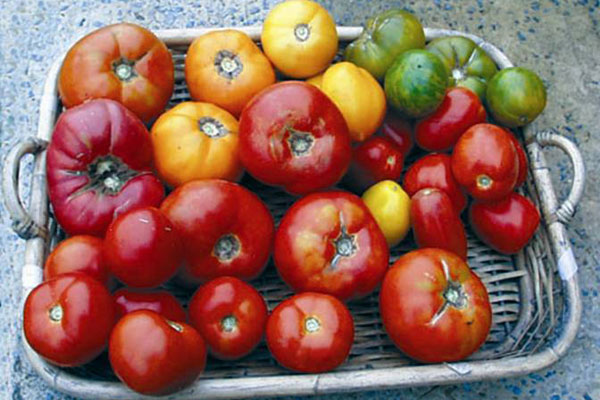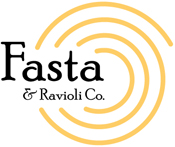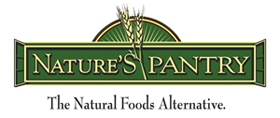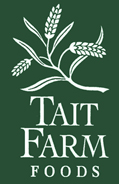-

Erin Donahue -

Christina Barkanic -

Brittany Trott -

Emily Wiley -

Jessica Reilley -

Chris Raines -

Will Nichols -

Emily Reddy -

Michele Marchetti -

Michele Frank -

James Gherardi -

Kit Henshaw -

Christina and Erin -

Kim Tait -

Erin McKinney -

Steve Spanelli -

Sam Komlenic -

Katherine Taylor Grofic -

James Eisenstein -

Jamie Oberdick -

Anna Lombardo -

LacCreta Holland -

Tony Ricci -

Local Food Journey -

Laura Young -

Kristin Camplese -

Harrison's Fresh + Local -

Danielle Matalonis -

Kristine A. -

Linda Weaver -

Naomi Elle Schwartz -

Dana Stuchul -

Cara McShane -

Brittany Smith -

Jessica Illuzzi - Frosty
-

Jessica Paholsky -

James Sechrengost -

Brad Yeckley -

Maya Althouse -

Jordan Reabold -

Kim Chase -

Maria Bryant - Alexandrea Scott
Heirloom Tomatoes
Posted by Tony Ricci on 08/09, 2011 at 12:26 PM

Basket of Heirloom Tomatoes. Photo Credit Tony Ricci.
There is a general consensus among marketers that an adjective can mean the difference between making a sale and bringing home ingredients for a gourmet compost pile. Flat parsley does not have the same resonance as Italian parsley. Without the appellation “French,” shallots would just be small, pale red onions. Then there is Red Russian kale which is neither truly red nor Russian (at least according to the Russian customers I’ve talked to who think it’s just another Ukrainian conspiracy). But who wants to say purple-stemmed blue-green, flat kale? It just doesn’t slide off the tongue with the same romantic flare. You can practically hear the balalaikas playing in the background when the words Red Russian are invoked.
The most notable prefix to come into vogue, of course, is heirloom, especially with regard to tomatoes. The term evokes not an exotic place, but an idealized past, when food had flavor and character. Chefs are no less susceptible to the lure of heirloom vegetables than other consumers, and even helped encourage the trend toward reviving older varieties that farmers had discarded or thought were not marketable. In many ways it was the interaction between chefs and farmers at local farmers markets that helped create the heirloom era. Trying to sell a Cherokee Purple to a large retailer would have been impossible 20 years ago; but because chefs were willing to experiment with new varieties and demanded flavor as much as looks, heirloom tomatoes eventually became a staple in the vegetable industry.
Anyone who has dabbled in the heirloom market understands the impediments to production that these varieties possess. Yield, of course, is often one of the main drawbacks. (Brandywine has notoriously low yields, but its delicate flavor still makes it a favorite among consumers.) Low disease resistance can also cut into production, especially in a wet year. And lastly, heirlooms often tend to be less uniform and cosmetically undesirable compared to their hybrid cousins.
Luckily for the farmer, flavor often trumps cat facing, cracking, and weird shapes (kind of like being middle aged but with a great personality). But it is important to understand the limits of imperfection. Most people still demand at least three good slices from a tomato no matter what royal family it comes from.
The term heirloom has become such a dominant term in the marketing lexicon that it’s often difficult to distinguish between what is merely unusual from what is truly a part of the historical legacy of a cherished line of tomatoes. Just giving a tomato a cool name doesn’t necessarily insure a higher market value. Cherokee Red tomatoes are nearly indistinguishable from a Big Boy, and you’ll need court documentation to convince a customer of legitimate heritage. But Elberta (a.k.a. Red Zebra) is not an heirloom but passes muster because of its unusual color and similarity to Green Zebra.
Perhaps these distinctions are best left to long philosophical discussions during the winter perusal of seed catalogs. Just recently I saw Rutgers touted as an heirloom and had to wince. But then I thought of that old farmer who managed to make it up to the top of the hill to my greenhouse and ask in his stoic manner, “You got any o’ them Ruckger tamatas?”
“Yeah, I got ‘em.”
“Good ‘cause ‘at’s all I grow.”
What more do you need to know about a tomato’s genealogy.
What’s your favorite tomato variety? And how do you like to eat it? Share your recipe for a chance to win a $25 gift certificate to Elk Creek Cafe + Aleworks.
![]() Author: Tony Ricci
Author: Tony Ricci
Bio: Co-owner and operator of Green Heron Farm in southern Huntingdon County | Provides year-round supplies of local, organic vegetables (retail and wholesale) across central Pennsylvania
- Our Local Food Journey comes to an end
- Winter isn’t a quiet time at the farm
- Get the taste of garden season right now by growing herbs indoors
- All you need to know about PASA’s Farming for the Future conference









NO COMMENTS